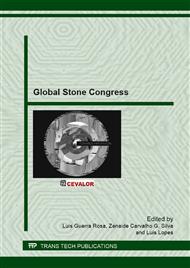p.82
p.90
p.98
p.106
p.115
p.124
p.135
p.141
p.147
Rock Properties versus Blades and Grit Consumption in Granite Multi Blade Sawing Process
Abstract:
Among the dimensional stone production processes, block splitting into slabs is very important in terms of time, costs and quality of final products. The world’s leading reference equipment for granite block cutting is the multi blade gang saw, in which sawing is the consequence of the combined action of a set of steel blades settled in an oscillating frame and an abrasive slurry containing water, steel shot and lime or bentonite. As the blades enter the block, stone powder is added to the abrasive slurry and as commercial granites include very different rock types, slurry characteristics also depend on the rock nature. Consequently, parameters of the cutting process have great variability. Depending on those parameters, the steel blades and shot are worn out differently during this process having great influence on costs. Due to its complexity, stone cutting mechanisms are still not well understood but compression, abrasion, impact and stone characteristics seem to influence the most. Aiming to help with the understanding of that process and based on previous studies, this work intends to establish correlations between granite petrographic and technological characteristics and steel blades and shot consumption. Laboratorial studies that include petrographic analysis, physical indexes measurement, and abrasion, impact and compression standardized testing of a selected group of stones are being crossed over with steel blades and steel shot consumption measurements in gang saws from several Brazilian processing companies. Although it is a study in progress, preliminary results show a relationship between the characteristics of selected stones and steel blades and shot consumption within the sawing process. The higher the quartz contents of the rock the higher its abrasion resistance, which results in higher consumption of steel shot during sawing. It can be also pointed out that beyond quartz and k-feldspar contents, microfissures seem to have influence on compression strength of the stones and this strength is directly related to the steel blades consumption. This can allow not only a better understanding of slabs production in multi blade gang saws process, but also to improve that process control.
Info:
Periodical:
Pages:
115-123
Citation:
Online since:
April 2013
Price:
Сopyright:
© 2013 Trans Tech Publications Ltd. All Rights Reserved
Share:
Citation:


